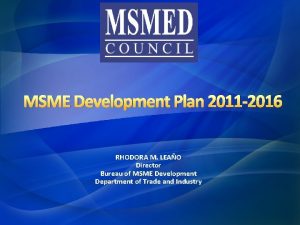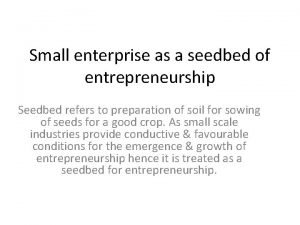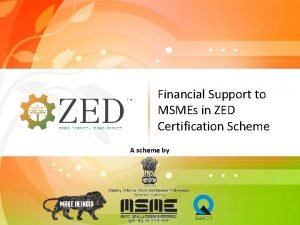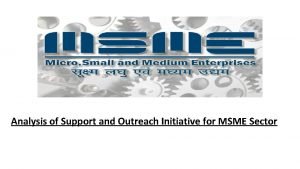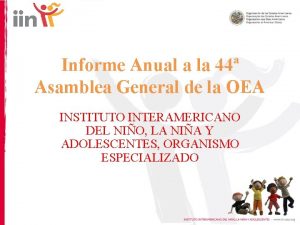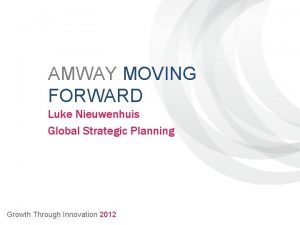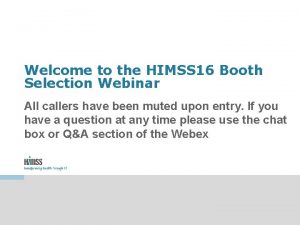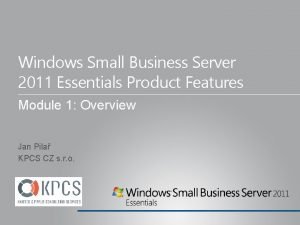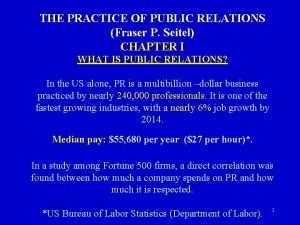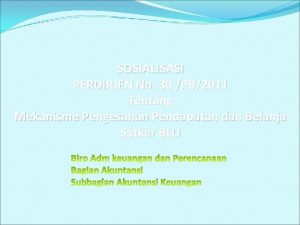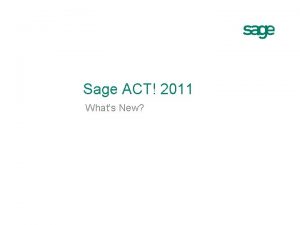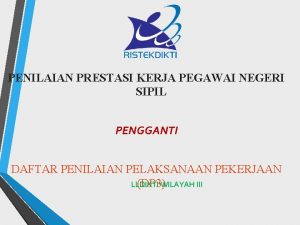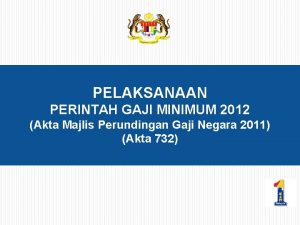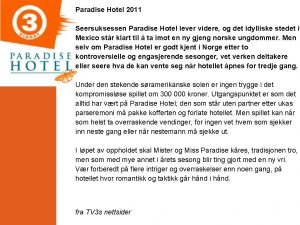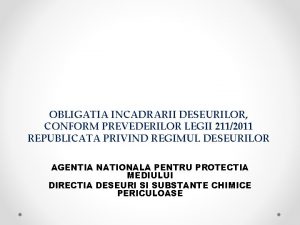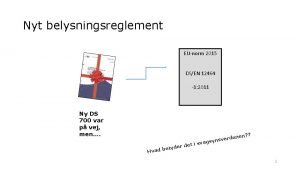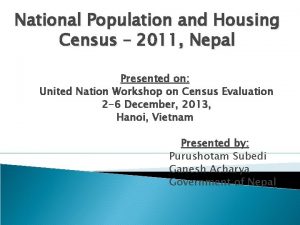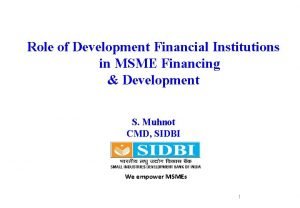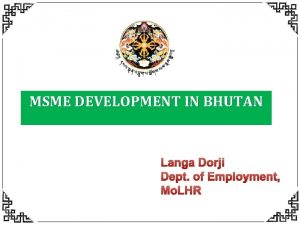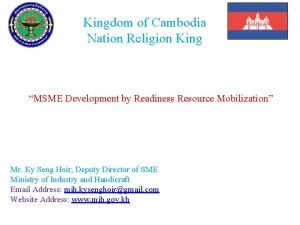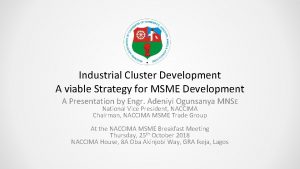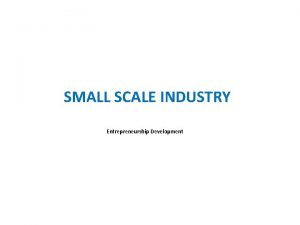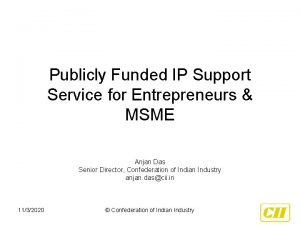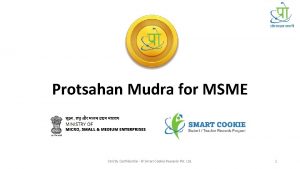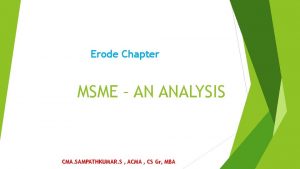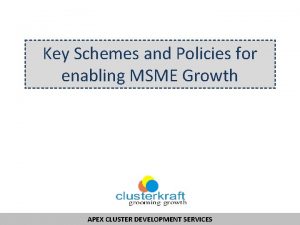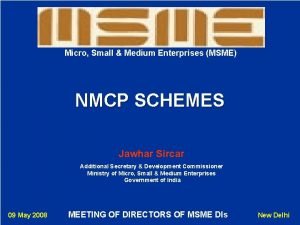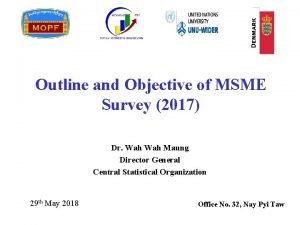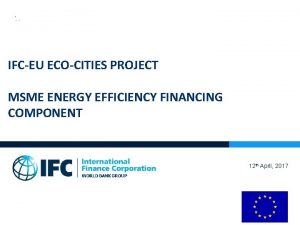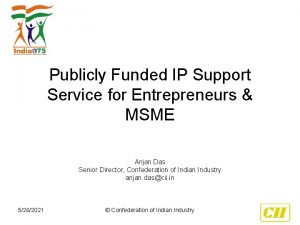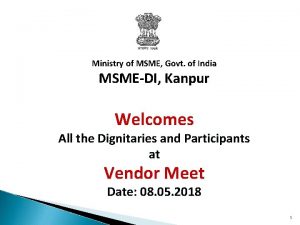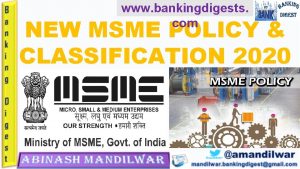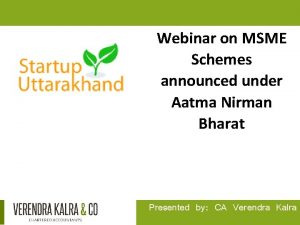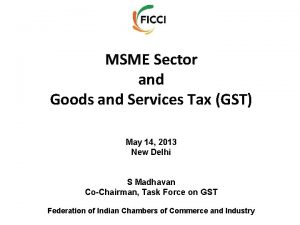MSME Development Plan 2011 2016 RHODORA M LEAO







































- Slides: 39

MSME Development Plan 2011 -2016 RHODORA M. LEAÑO Director Bureau of MSME Development Department of Trade and Industry

Outline • Overview of Philippine MSMEs • Highlights of Accomplishments on SME Development 2004 -2010 • MSMED Plan 2011 -2016 • MSMED Council

Highlights of Accomplishments on SME Development 2004 -2010 • Increased value added of the sector from 32% to 35. 7% • Generated 6. 5 million direct and indirect jobs • Provided Php 367. 39 billion in loans to address 6. 3 million requests by MSMEs for credit and other forms of financial support • Generated Php 20. 12 billion worth of domestic sales and U. S. $1. 8 billion of export sales • Provided capacity building programs to enhance the level of competitiveness of over 115, 000 MSMEs

Take-Aways from SMED Plan 20042010 • All stakeholders both at the national and local levels need to work together to maximize development impact. • We need to improve knowledge management and monitoring and evaluation and make them more participatory. • We need to marry the top down with a bottom up development approach.

MSME Development Plan 2011 -2016 • To address the key challenges and constraints that continue to prevent the MSME sector from realizing its full potential and boosting the country’s industrial growth • Developed in close consultation with national, regional and provincial stakeholders • Key industry areas such as (tourism, BPO, electronics, mining, housing, agribusiness, logistics, shipbuilding, infrastructure, and other high-potential industries like homestyle products, wearables, motor vehicles parts and components, garments, and construction materials)

Challenges Business Environment (BE) 1. 2. 3. 4. 5. High cost of doing business (taxes, fees, etc. ) Registration and licensing procedures are tedious, lengthy and complicated Efforts to develop a BE are not coordinated, harmonized and sustained by concerned agencies Laws and policies supporting MSME development are not fully enforced Several regions lack investment codes while some regions that do, are not implementing them

Challenges Business Environment (BE) 6. Business development is too focused on micros’ development with little attention given the concerns of SMEs 7. Several regions lack the infrastructure and utilities needed to promote business and investments 8. Some regions are prone to risks (i. e. peace and order, natural disasters, etc. ) 9. Enablers lack the capacity to support and promote the MSME sector

Challenges Access to Finance (A 2 F) 1. SMEs find difficulty in accessing available funds from financial institutions because of stringent and voluminous requirements and long processing time of loan applications 2. The interest rate charged is very high 3. SMEs find the minimum loan requirement and the short repayment period restrictive 4. The financial packages for SMEs in several regions are only available in urban areas 5. SMEs lack the capacity for financial management

Challenges Access to Finance (A 2 F) 6. There are no funds available for start-up SMEs in several regions 7. SMEs do not have access to venture capital funds 8. It is difficult to restructure loans 9. SMEs have limited access to information regarding the sources of funds and on how to access these

Challenges Access to Markets (A 2 M) 1. SMEs are not proactive in seeking markets and responding to market needs 2. Stiff competition from unregistered enterprises and cheap imports are eroding the SMEs’ market share 3. SMEs have limited access to organized marketing networks of independent consolidators 4. Marketing support for SMEs given by stakeholders is not coordinated

Challenges Access to Markets (A 2 M) 5. SMEs have poorly packaged and labelled products 6. SMEs have limited capacity for product development and design 7. SMEs lack the capacity to use modern technology, i. e. Internet, for marketing purposes 8. SMEs lack the certification and accreditation needed to penetrate new markets 9. SMEs lack access to market information

Challenges Productivity and Efficiency (P&E) 1. 2. 3. 4. 5. 6. The unsteady supply and high cost of water and electricity reduce the productivity of SMEs lack information and education on productivity The level of productivity of SMEs is reduced by their poor working conditions arising from non-compliance with labor laws The production systems of SMEs are not environmentfriendly SMEs lack the knowledge and capacity to comply with international quality standards SMEs suffer from piracy of highly skilled workers

Challenges Productivity and Efficiency (P&E) 7. Vocational and technical schools do not offer learning programs that are responsive to MSME needs 8. ICT use among SMEs is not pervasive 9. SMEs are not investing in productivity-enhancing technologies 10. The services of government-subsidized technology/packaging centers are expensive 11. SMEs are unable to access productivity programs due to their high cost

MSME Development Plan 2011 -2016 Strategic Framework • The new plan envisions a more focused implementation of measures • It is meant to deliver a set of results that would lead to the creation of employment and the improvement in the value added contribution of the SMEs sector.

MSME Development Plan 2011 -2016 The Plan is meant to: • Create a business environment that will center around a culture of governance that will foster the establishment, development, sustainability, and competitiveness of SMEs • Improve the availability of reasonably priced financial products, services and support programs that SMEs can conveniently access

MSME Development Plan 2011 -2016 The new Plan is meant to: • Improve the sustainability of SMEs to be competitive in selling their products and services to existing and new markets, domestically and internationally, under a climate of fair and free trade • Improve the production and delivery of competitive, standards compliant and environment-friendly products and services that will generate optimum economic returns for SMEs • Take into consideration global themes and cross-cutting issues related to gender, climate change, corporate social responsibility and migration.

MSME Development Plan 2011 -2016 Creating employment and increasing GDP Contribution The new Plan aims to: • Create 2 million employment in new and sustainable jobs by 2016 • Raise the economic contribution of SMEs to 40% of gross value added to be at par with the share of the SME sector to GDP of other countries in the region.

POVERTY REDUCTION The contribution of the MSME sector to GVA has increased to 40% by 2016 BE A 2 F MSME sector employment has reached 2 million by 2016 A 2 M P&E

BE Results Statements The contribution of the MSME sector to GVA has increased to 40% by 2016 A 2 F MSME sector employment has reached 2 million by 2016 A 2 M P&E Business Environment (BE) 1. The cost of doing business (taxes, fees, etc. ) is affordable to MSMEs. 2. The institutional support structures for the development of start-up and existing MSMEs are in place. 3. The policies necessary to develop the MSME sector are crafted and being fully implemented. 4. Support for MSME development is results based, coordinated, harmonized and sustained by capable stakeholders. 5. An entrepreneurial mindset is pervasive among MSMEs and other MSME stakeholders. 6. Soft and hard infrastructures for MSME development are established. 7. The information needs of MSMEs are available and accessible. 8. MSMEs are gender responsive and environment-friendly.

A 2 F Results Statements The contribution of the MSME sector to GVA has increased to 40% by 2016 BE MSME sector employment has reached 2 million by 2016 A 2 M P&E Access to Finance (A 2 F) 1. The financial products, services and support programs that MSMEs need are sustainably available even to start-up MSMEs and MSMEs operating in the countryside. 2. The cost of obtaining MSME loans is reasonable and affordable. 3. The requirements that MSMEs need to comply with to obtain loans are reasonable and manageable. 4. The process that MSMEs need to follow and documents that must be submitted to obtain loans is simplified and streamlined. 5. MSMEs are trained in financial management and are able to understand speak the language of financial institutions, while financial institutions are trained to understand speak the language of MSMEs. 6. Financial products and services for MSME lending are gender-responsive and environment friendly. 7. The information needed by MSMEs to access financial resources are available and easily accessible. 8. The assistance extended by stakeholders to MSMEs in accessing funds are coordinated, relevant and effective.

A 2 M Results Statements The contribution of the MSME sector to GVA has increased to 40% by 2016 BE MSME sector employment has reached 2 million by 2016 A 2 F P&E Access to Markets (A 2 M) 1. MSMEs have maintained their existing markets and penetrated new and emerging markets locally and globally. 2. MSMEs are competitive locally and globally. 3. Marketing support systems are established and are operating on a sustainable basis. 4. MSMEs are implementing the value chain approach and are highly benefited by it. 5. MSMEs are using information technology and intellectual property system to develop a sustainable market share and gain competitive advantage for their products and services. 6. Market information needed by MSMEs is available and freely accessible. 7. MSMEs have considerable share in the sustainable development market locally and globally. 8. Government support programs (e. g. One Town, One Product (OTOP) Program) to help MSMEs access local and global markets are coordinated and highly satisfactory.

P&E Results Statements The contribution of the MSME sector to GVA has increased to 40% by 2016 BE A 2 F MSME sector employment has reached 2 million by 2016 A 2 M Productivity and Efficiency (P&E) 1. Government programs and policies on productivity enhancement are coordinated, effective and highly satisfactory. 2. The MSME workforce is highly motivated and is equipped with the appropriate skills and attitude needed by MSMEs. 3. The working environment of MSMEs fosters greater productivity and efficiency among the workforce. 4. MSMEs are using gender-responsive and environment friendly technologies. 5. MSMEs are compliant with international quality standards. 6. MSMEs are using state of the art productivity enhancing technologies. 7. Information on productivity enhancement is available and freely accessible to MSMEs.

MSME Development Strategy and Approach Globalization n ge an Ch e Cl Co Re rpo Market System sp rat on e S Development sib oc ili ial ty at A 2 M im Lo c Co al an mp d eti Reg tiv ion en al es s MSME P&E er A 2 F tor ess Sec itiven et mp BE nd igr Co M Ge io at Regional Integration

Implementation Approach Local and Regional Economic Development Globalization er Regional Integration ge an Ch • promotes market based solutions e at Co r Re por Market System sp at Development on e S sib oc i ilit al y • espouses the principles of subsidiarity and participatory development • advocates the paradigm that a local government unit (LGU) is an economic space A 2 M im P&E Cl Lo Lo. C cal a co nd l Co am mp apnedtit Reg eti Rievge ion tiv inoen al en sasl es s nd A 2 F MSME tor ess Sec itiven et mp Co BE Ge ion at igr M • catalyzes the establishment of upstream and downstream economic activities • adopts a systemic view to local competitiveness

Implementation Approach Sector Competitiveness Globalization Lo c Co al an mp d eti Reg tiv ion en al es s er ttoorr eessss SSeecc itiivveenn peet ommp Co. C • fosters cooperation and trust thereby improving the competitiveness of entire value chains • encourages the development by stakeholders of consistent and relevant strategies in keeping with the principle of participatory development A 2 F MSME Regional Integration an Ch e at Co r Re por Market System sp at Development on e S sib oc i ilit al y ge A 2 M im P&E Cl BE nd Ge at igr M

Implementation Approach Market System Development Globalization develops the competitiveness of market actors including the private sector, government, business membership organizations, and informal networks • promotes efficiency in the use of government funds an Ch e at Cl Co r Re por Market System sp at Market System Development on e S sib oc Development ilit ial y ge A 2 M im Lo c Co al an mp d eti Reg tiv ion en al es s • er allows stakeholders to address market failures both at the demand supply sides of the service market tor ess Sec itiven et A 2 F MSME P&E • mp Co BE nd Ge at igr M Regional Integration

Global Themes Globalization Gender ion • encourages local stakeholders to analyze the business environment for the key characteristics and the context in which female and male entrepreneurs operate • focuses on women’s and men’s access to resources and opportunities r an Ch e at im Co r Re por Market System sp at Development on e S sib oc i ilit al y ge A 2 M Cl P&E de Lo c Co al an mp d eti Reg tiv ion en al es s r de A 2 F MSME tor ess Sec itiven et mp Co BE n n Ge Ge at igr M Regional Integration

Global Themes Migration Globalization iioonn t at • improves the demand for MSME products and services in the Philippines and abroad • increases know-how (brain gain) of the OFs leading to new forms of businesses, knowledge transfer, and raises the productivity and efficiency of MSMEs. Regional Integration an Ch e at Co r Re por Market System sp at Development on e S sib oc i ilit al y ge A 2 M im P&E Cl Lo c Co al an mp d eti Reg tiv ion en al es s er nd A 2 F MSME tor ess Sec itiven et BE mp Co M raises potential investment capital for the establishment of MSMEs in the countryside Ge ig. Mrigra •

Global Themes Globalization BIEE A 2 F MSME • can bring business opportunities to MSMEs • leads to greater resource productivity and efficiency A 2 M Cl Co r Re por Market System sp at Development on e S sib oc i ilit al y Cilm ima att ee Ch. C ahn a gen g e P&E tor ess Sec itiven et mp Co Lo c Co al an mp d eti Reg tiv ion en al es s er nd Ge at igr M Climate Change/Green Growth Regional Integration

Global Themes Corporate Social Responsibility Globalization ge Lo c Co al an mp d eti Reg tiv ion en al es s • MSMEs can be the beneficiaries of CSR activities such as capacity building or technology transfer programs • MSME operational “code of ethics” nd MSMEs can supply raw materials and services to large enterprises tor ess Sec itiven et A 2 F MSME P&E • mp Co BE er Ge at igr M A 2 M Co. C Re. Re rprpoo Market System spsp rrat oonn ee SS Development ssiibbi oocica illiity ilal ty Cl im at e Ch an o Regional Integration

Global Themes Globalization promotes the participation of SMEs in global production networks through outsourcing and subcontracting activities • maximizes opportunities for SMEs in a more open and highly competitive market Regional Integration an Ch e at Co r Market System Re por sp at Development on e S sib oc ilit ial y ge A 2 M im P&E • Cl Lo c Co al an mp d eti Reg tiv ion en al es s er A 2 F MSME tor ess Sec itiven et BE Globalization nd Ge n mp Co io at r g i M Regional Integration

MSME Development Plan 2011 -2016 It is envisioned that the Plan will be implemented through a stronger convergence of stakeholders efforts with regular monitoring, validation and updating under the stewardship of the national and local Micro, Small and Medium Enterprise Development Councils.

MSMED COUNCIL MEMBERSHIP (RA 9501: Magna Carta for MSMEs) Chairman: Secretary of Trade and Industry Members: Government sector Secretary of Agriculture Secretary of Interior and Local Government Secretary of Science and Technology Secretary of Tourism Chairman of Small Business Corporation Private sector MSME Representatives for Luzon, Visayas and Mindanao Banking Sector Representative Labor Sector Representative

MSMED COUNCIL MEMBERSHIP Additional Members Per Executive Order No. 793 People’s Credit and Finance Corporation National Livelihood Development Corporation Cooperative Development Authority UP-Institute for Small Scale Industries Permanent Resource persons National Economic and Development Authority (NEDA) Bangko Sentral ng Pilipinas (BSP) Congressional Oversight Committee: - Senate: Economic Affairs - Congress: Small Business and Entrepreneurship

MSMEDC POWERS AND FUNCTIONS (RA 9501: Sec. 7 -B) Help establish the needed environment and opportunities conducive to the growth and development of the MSME sector Recommend to the President and Congress all policy matters affecting MSMEs Coordinate and integrate various government and private sector activities relating to MSME development

MSMEDC POWERS AND FUNCTIONS (RA 9501: Sec. 7 -B) Review existing policies of government agencies that would affect the growth and development of MSMEs and recommend changes to the President and Congress thru the Senate Committee on Economic Affairs and HOR Committee on Small Business and Entrepreneurship Monitor and determine the progress of various agencies geared towards the development of the MSME sector. Includes overseeing, in coordination with LGUs and DILG as well as private sector groups/associations, the development of MSMEs

MSMEDC POWERS AND FUNCTIONS (RA 9501: Sec. 7 -B) Promulgate implementing guidelines, programs and operating principles Provide the appropriate policy and coordinative framework in assisting relevant government agencies, in coordination with the NEDA and CCPAP, in tapping local and foreign funds for MSME development Promote the productivity and viability of MSMEs by way of directing and/or assisting relevant government agencies and institutions at the national, regional and provincial levels.

MSMEDC POWERS AND FUNCTIONS (RA 9501: Sec. 7 -B) Through appropriate agencies of government: Provide more infrastructure facilities and public utilities to support operations of MSMEs Establish, operate and administer a small business incubation program Conduct a nationwide information campaign with the PIA Provide local and international linkages for MSME development Compile and integrate statistical databank on Philippine MSMEs Submit to the President and the Congress thru the Oversight Committee a yearly report on the status of MSMEs in the Philippines Coordinate, monitor and assess the implementation of the MSME Development Plan

Thank you. BUREAU OF MICRO, SMALL AND MEDIUM ENTERPRISE DEVELOPMENT 5/F, Trade and Industry Building, 361 Sen. Gil J. Puyat Avenue, 1200 Makati City, Philippines Trunkline (632) 7510. 384 • Fax (632) 896 -7916 • E-mail: bmsmed@dti. gov. ph www. dti. gov. ph As of March 11, 2011
 Msme development plan
Msme development plan The seedbed for the new venture
The seedbed for the new venture Francisco leão diegues
Francisco leão diegues Fábulas de esopo o leão e o rato
Fábulas de esopo o leão e o rato Zed certification benefits
Zed certification benefits Msme
Msme Competencias para la vida plan de estudios 2011
Competencias para la vida plan de estudios 2011 Plan y programa 2011
Plan y programa 2011 The r.a. no. 10912 was enacted on
The r.a. no. 10912 was enacted on Amway 6 4 2 plan
Amway 6 4 2 plan Himss 2016 floor plan
Himss 2016 floor plan Definition of community development
Definition of community development Development that ended much development crossword
Development that ended much development crossword Development of truncated cylinder
Development of truncated cylinder Wyd 2011 madrid
Wyd 2011 madrid Small business server 2010
Small business server 2010 Windows small business server 2011 essentials
Windows small business server 2011 essentials Seitel (2011) views public relations as:
Seitel (2011) views public relations as: Enem 2011 uma equipe de cientistas
Enem 2011 uma equipe de cientistas Per-30/pb/2011
Per-30/pb/2011 Kidush de shavuot
Kidush de shavuot Dorothea puente young
Dorothea puente young Sage act 2011
Sage act 2011 Chemistry regents 2011
Chemistry regents 2011 2011-1989
2011-1989 There names
There names Perfil de egreso de primer grado de primaria pdf
Perfil de egreso de primer grado de primaria pdf Pergub 140 tahun 2011
Pergub 140 tahun 2011 Contoh penilaian prestasi kerja
Contoh penilaian prestasi kerja Usa infotehnoloog 1955-2011
Usa infotehnoloog 1955-2011 Akta majlis perundingan gaji negara 2011
Akta majlis perundingan gaji negara 2011 Paradise hotel 2011 deltakere
Paradise hotel 2011 deltakere Legea 211/2011
Legea 211/2011 Ds/en 12464-1:2011
Ds/en 12464-1:2011 National population and housing census 2011
National population and housing census 2011 Eecs2011
Eecs2011 Unieważnienie matury 2011
Unieważnienie matury 2011 Lof 2011
Lof 2011 How can you import your movie assets to wlmm
How can you import your movie assets to wlmm How can you import your movie assets to wlmm?
How can you import your movie assets to wlmm?
